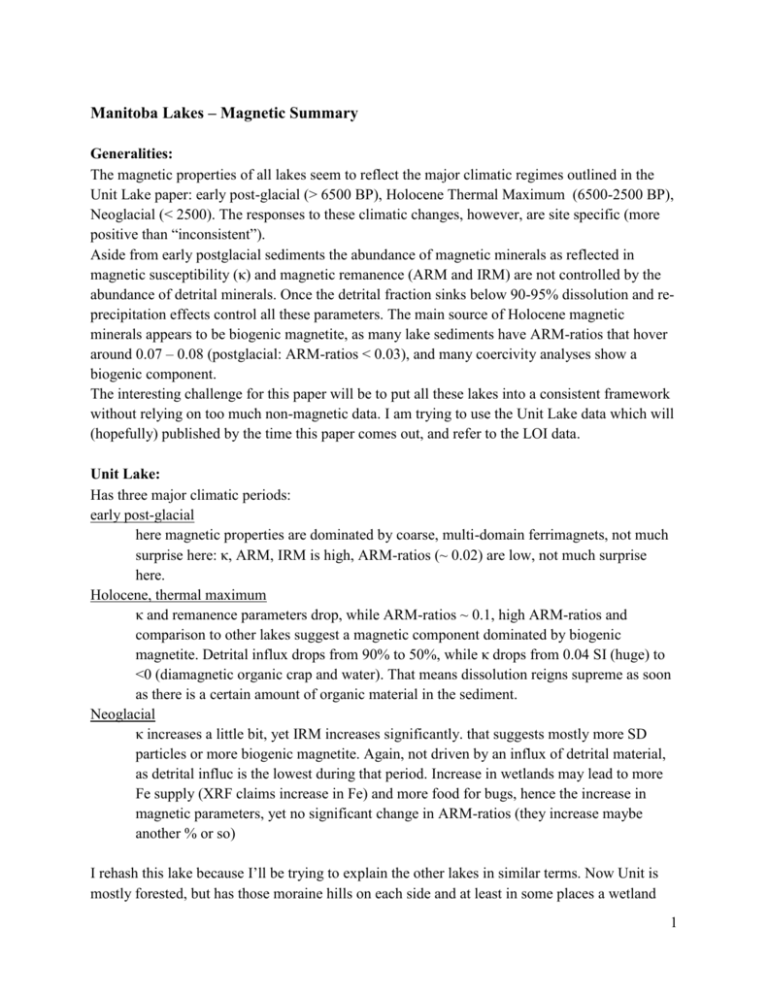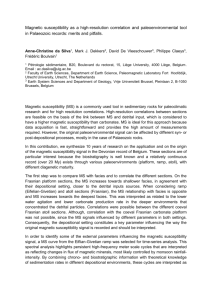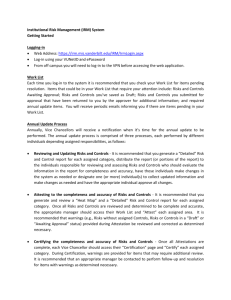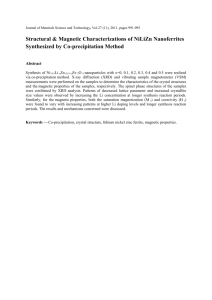Manitoba Lakes – Magnetic Summary
advertisement

Manitoba Lakes – Magnetic Summary Generalities: The magnetic properties of all lakes seem to reflect the major climatic regimes outlined in the Unit Lake paper: early post-glacial (> 6500 BP), Holocene Thermal Maximum (6500-2500 BP), Neoglacial (< 2500). The responses to these climatic changes, however, are site specific (more positive than “inconsistent”). Aside from early postglacial sediments the abundance of magnetic minerals as reflected in magnetic susceptibility (κ) and magnetic remanence (ARM and IRM) are not controlled by the abundance of detrital minerals. Once the detrital fraction sinks below 90-95% dissolution and reprecipitation effects control all these parameters. The main source of Holocene magnetic minerals appears to be biogenic magnetite, as many lake sediments have ARM-ratios that hover around 0.07 – 0.08 (postglacial: ARM-ratios < 0.03), and many coercivity analyses show a biogenic component. The interesting challenge for this paper will be to put all these lakes into a consistent framework without relying on too much non-magnetic data. I am trying to use the Unit Lake data which will (hopefully) published by the time this paper comes out, and refer to the LOI data. Unit Lake: Has three major climatic periods: early post-glacial here magnetic properties are dominated by coarse, multi-domain ferrimagnets, not much surprise here: κ, ARM, IRM is high, ARM-ratios (~ 0.02) are low, not much surprise here. Holocene, thermal maximum κ and remanence parameters drop, while ARM-ratios ~ 0.1, high ARM-ratios and comparison to other lakes suggest a magnetic component dominated by biogenic magnetite. Detrital influx drops from 90% to 50%, while κ drops from 0.04 SI (huge) to <0 (diamagnetic organic crap and water). That means dissolution reigns supreme as soon as there is a certain amount of organic material in the sediment. Neoglacial κ increases a little bit, yet IRM increases significantly. that suggests mostly more SD particles or more biogenic magnetite. Again, not driven by an influx of detrital material, as detrital influc is the lowest during that period. Increase in wetlands may lead to more Fe supply (XRF claims increase in Fe) and more food for bugs, hence the increase in magnetic parameters, yet no significant change in ARM-ratios (they increase maybe another % or so) I rehash this lake because I’ll be trying to explain the other lakes in similar terms. Now Unit is mostly forested, but has those moraine hills on each side and at least in some places a wetland 1 shelf, providing quite a bit of detrital input, some of which may be trapped in those wetland regions. Lake 785: This is probably one of our better magnetic records, so it’s a good place to start: susceptibility is all blown up, so one can see Holocene changes. early post-glacial: high concentrations of detrital material until 7.25 ka, transitional period until 6.5 ka, again high concentrations of coarse-grained ferrimagnets, high κ, IRM (ARM not so much), low ARM-ratio. Coercivity distributions for IRM show broad, soft distribution characteristic of detrital input. HTM: detrital input drops to 80%, but κ decreases by 90% or so. κ is weak, but always positive, stays low until 2.5 ka. ARM-ratios ~ 0.06, so we have a mixture between detrital and biogenic magnetite. 2 There is a sharp increase in remanence parameters (ARM and IRM) at 5.5 ka, which doesn’t correlate with anything non-magnetic that I can think of. ARM-ratios remain at 0.06, so I’ll ignore that for now. neoglacial: slight increase in κ at 2.5 ka, increase in ARM later at 1.5 ka. MCA represented by high detrital input, reflected in κ, but overridden by biogenic magnetite, which is visible in the coercivity distributions and leads to higher ARM-ratios ~0.08. interesting: Unit – detrital , 785 – detrital , in both cases ARM-ratio increases, and topmost seds of 785 show ARM dominated by biogenic magnetite. Fe increases over past 3ka. no sphagnum data. Lake 614 is close by, so might as well take it next: well, the record is short, so there is no post-glacial to worry about and we start out in the HTM 3 which is controlled by a mixture of detrital and biogenic magnetite. The detrital component is not a pure shoreline component. The red coercivity distribution is the shoreline sample and its more or less absent during the HTM, but there is some softer component in there as well. It seems to be a bit too soft for pedogenic mt and the soils up here are so crappy that soil formation isn’t really an issue anyway. Neoglacial Starts early at about 3.5 ka and shows a reversal back to lower κ, IRM, ARM, a coarsening of the magnetic grain-size (ARM-rations ~ 0.02) and an increase in coercivity distributions that are very similar to the shoreline sample. LOI data might back that up: inorganic material might go up a tad. Interesting enough CN-ratios jump a bit (more terrestrial carbon)? Another interesting tidbit: high Fe abundances seem to be associated with high ARMratios and increases in κ and sometimes remanence. So the high abundances of biogenic magnetite seem to be linked to periods of relatively high Fe abundance. Ignore the inclination record for now. 4 Lake 630 Is the last of the southern lakes, in forest, it also seems the most homogenous (almost said boring) or subtle… post-glacial same-old, same-old, coarse, detrital ferrimagnets, I’d say it ends at 7.5k HTM after a low-κ transition period, where κ is almost zero, but still slightly positive, κ recovers to quite high values κ ~ 15 x 10-6SI not bad), not sure about the nature of these 1-2 datapoint drops that go almost to zero. Uneven core surface, cracks in the core, poor contact with core surface in general, or something real. In any case, ARM-ratios ~ 0.07 are consistent again with mostly biogenic crap and a few detrital grains, which is confirmed by the coercivity distributions. 5 Neoglacial well, maybe, a little dip in κ at 2.0ka, followed by a real drop at 800 a. Not much to say here from the magnetic side of things. LOI-wise it’s a pretty boring lake as well. Not much change, just a long, gentle decline in detrital stuff, mirrored by a long, gentle increase in organics. Fe stays consistently high, but CaCO3 drops at 2.0 ka. Not a very sensitive site? Lake 396 is generally very weakly magnetized, which is not from a lack of detrital material (at base 100%). 6 Even in the post-glacial, when the sediment consists of 100% detrital material κ ~ 10 x 10-6SI (that’s as weak as the HTM in some of the stronger magnetized lakes) IRM is also weaker than, say Lake 785 etc. ARM-ratios are relatively high ~0.05%, suggesting a rather different parent material. Pooja’s soil profile measurements might back that up: C-horizon IRM’s for most lakes are about 0.8 – 1.0 Am2/kg, Lake 396 soils come in at 0.25 – 0.5 Am2/kg HTM is characterized by diamagnetic sediments (κ < 0), record is noisy, probably because of weak signal strength. ARM-ratios are a pretty mediocre 0.05. We have no coercivity distributions for this site, so it’s hard to say what’s going on. Neoglacial is a bit finer grained, but that’s only visible in the ARM-ratios, which increase slightly to 0.075. Coercivity distributions are a bit lame. Lower distributions (there are none for drives 3 & 5) are not demagnetized at 160 mT (the maximum available field at the in-line AFD), so the fits are horrible as there is no right hand side to fit. the two uppermost samples (and many others from that section) are a bit better, but the presence of a high-coercivity component messes up the fits as it would significantly overlap with a biogenic magnetite signal, which I think is still there, but one can’t deduce it from the coercivity data. On to the last two lakes 111 and 150. 111 has the uglier data, so let’s start with that one: Lake 111 had serious issues with the magnetometer. The plastic tape that closes the ends of the U-channels got caught on the magnetometer, pushing the U-channel to the wrong position. So there are ARM and IRM data missing. To make matters worse, the ARM of the lowermost core is off for some reason, so ARM data are really scarce. For that reason I plotted κ/IRM to estimate SD parameters, which is iffy. The idea is that κ is at a minimum for SD, while IRM is at a maximum (yet not so dramatically as with ARM). so plenty of SD would translate into low κ and relatively high IRM, lowering κ/IRM. The fact that κ is generally low and switches sign complicates matters. 7 Nevertheless, the little insert shows ARM-ratio as a function of κ/IRM, and the blue data (from Liv 3 and Liv 1) are pretty good. κ/IRM is also a pretty continuous record, suggesting a gradual fining between 8 ka to 5.5 ka, a SD-rich period between 5.5 and 3.0 ka (or 3.5), and a coarsening from 3 ka upwards. It should be pointed out that the sediments are really weakly magnetic, even though sediments contain > 70% inorganic matter. Again, it’s not dilution by organic matter, but dissolution. The high degree of dissolution lets the high-coercivity component of the sediments shine through. Only the topmost coercivity distribution is reasonably demagnetized at 160 mT. The others are noisy and still pretty magnetic at 160 mT resulting in crappy fits. 8 Lake 150 has no coercivity distributions, but a few hysteresis loops- thanks Charles! just like Lake 111 and 396, the sediments are rather weakly magnetic, despite 70% inorganic material. post-glacial high κ, IRM, ARM, coarse grained, loops show mostly MD – nothing new here HTM low κ, medium fine grained ARM-ratios ~ 0.05. no hysteresis data neoglacial: κ slightly positive but low, Fe conc. increase gradually from early HTM to present, ARM-ratios increase to 0.07 – 0.08, but grain size change precedes κ increase by about 1000 years. Given all the other lakes, I think it’s a pretty safe bet to say that the fine grained component is biogenic in origin again. but there’s a mix of detrital residual grains and biogenic magnetite. 9







